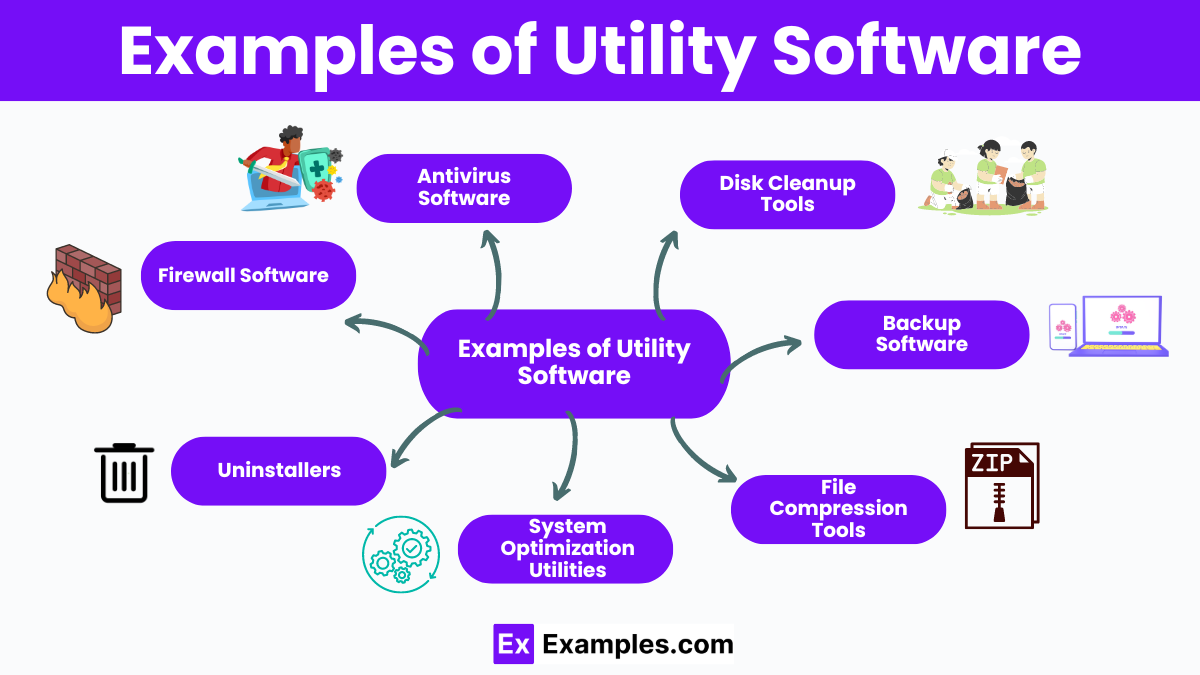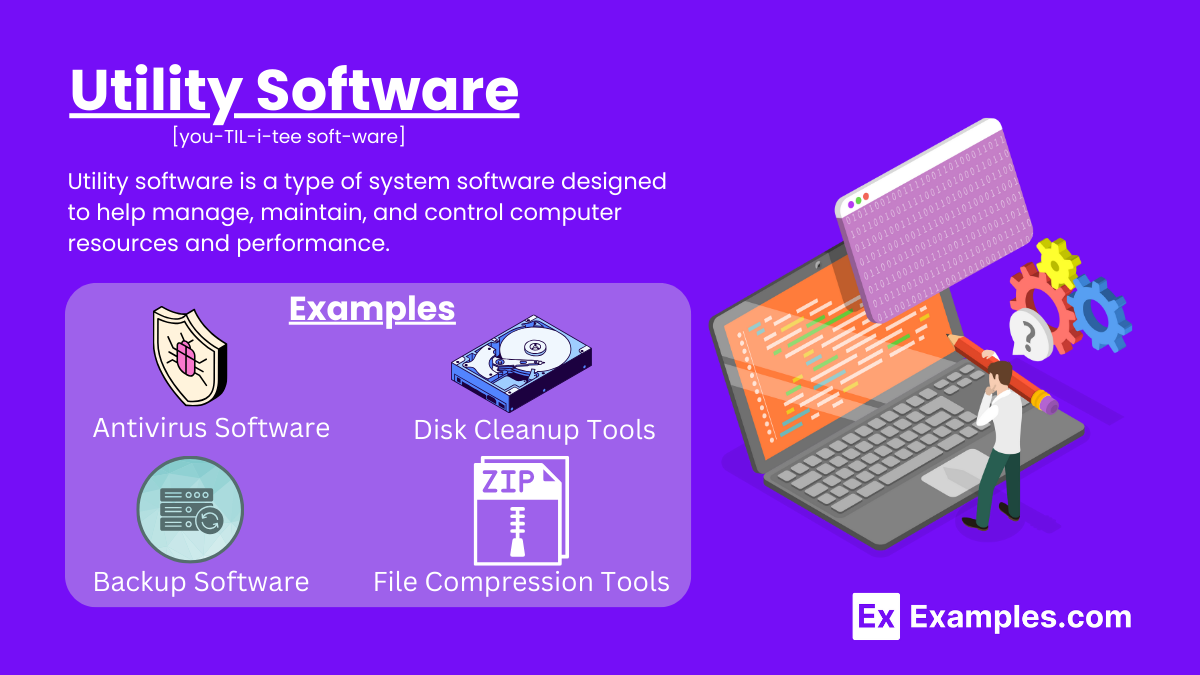Utility Software – Examples, Uses, Tools, Advantages & Disadvantages
Utility software comprises a suite of programs designed to augment computer performance and streamline operational tasks. Its multifaceted functionalities encompass crucial aspects of system management and optimization. Among its core features are software evaluation tools, which empower users to assess the efficacy and compatibility of various programs within their system environment. Additionally, utility software facilitates software inventory management, allowing organizations to comprehensively track and regulate their software assets. Through meticulous software inventory control, users can efficiently manage licenses, updates, and usage metrics. Furthermore, utility software aids in troubleshooting and diagnostics, providing essential tools for error identification and resolution. Overall, utility software serves as a cornerstone in optimizing system functionality, enhancing security, and maintaining operational efficiency in diverse computing environments.
What is Utility Software?
Utility software refers to programs designed to assist with system management, optimization, and maintenance tasks on computers. It includes tools for tasks such as software evaluation, data backup, antivirus protection, disk cleanup, and more. Utility software aims to enhance system performance, security, and overall efficiency.
Examples of Utility Software

- Antivirus Software: Examples include Norton Antivirus, McAfee Antivirus, and Avast Antivirus. These programs protect computers from viruses, malware, spyware, and other online threats.
- Disk Cleanup Tools: Windows Disk Cleanup, CCleaner, and CleanMyPC are examples of tools that remove temporary files, cache, and other unnecessary data from the disk to free up space and improve performance.
- Backup Software: Acronis True Image, EaseUS Todo Backup, and Macrium Reflect are examples of backup software that automate the process of creating backups for files, folders, and entire system configurations to prevent data loss.
- File Compression Tools: WinRAR, 7-Zip, and WinZip are examples of tools that compress files and folders to reduce their size, making them easier to store, transfer, and share.
- System Optimization Utilities: Advanced SystemCare, AVG PC TuneUp, and Glary Utilities are examples of utilities that optimize system performance by cleaning up the registry, managing startup programs, and optimizing system settings.
- Uninstallers: Revo Uninstaller, IObit Uninstaller, and Geek Uninstaller are examples of tools that completely remove unwanted programs and their associated files from the system, ensuring thorough uninstallation.
- Firewall Software: Windows Firewall, Comodo Firewall, and ZoneAlarm are examples of firewall software that monitor and control incoming and outgoing network traffic to prevent unauthorized access and protect against cyber threats.
- Disk Defragmenters: Windows Disk Defragmenter, Defraggler, and Auslogics Disk Defrag are examples of tools that reorganize fragmented data on hard drives to improve access speeds and optimize disk performance.
- System Monitoring Tools: HWMonitor, Speccy, and Open Hardware Monitor are examples of tools that monitor system performance metrics such as CPU temperature, memory usage, and disk activity.
- File Recovery Software: Recuva, Stellar Data Recovery, and MiniTool Power Data Recovery are examples of software that recover lost or deleted files from storage devices, helping users retrieve accidentally deleted or corrupted data.
Advantages and Disadvantages of Utility Software
| Advantages of Utility Software | Disadvantages of Utility Software |
|---|---|
| 1. Enhances system performance and efficiency. | 1. Some utility software may consume system resources, leading to slower performance. |
| 2. Improves security by providing antivirus protection, firewall, and other security features. | 2. Utility software can sometimes conflict with other software, causing compatibility issues. |
| 3. Streamlines tasks such as data backup, disk cleanup, and software management, saving time and effort. | 3. Utility software may require frequent updates and maintenance to remain effective and secure. |
| 4. Helps in organizing and managing digital assets such as files, programs, and system configurations. | 4. Certain utility software may come with a cost, especially premium versions with advanced features. |
| 5. Facilitates troubleshooting and diagnostics, allowing users to identify and resolve system issues promptly. | 5. Inexperienced users may misconfigure or misuse utility software, leading to unintended consequences or system instability. |
| 6. Provides tools for data recovery, allowing users to retrieve lost or deleted files from storage devices. | 6. Utility software can sometimes pose privacy risks if it collects and shares user data without consent. |
Uses for Utility Software
Utility software is designed to help manage, maintain, and control computer resources. Here are several key uses for utility software:
1. System Maintenance
- Disk Cleanup: Frees up space on the computer by removing unnecessary files.
- Disk Defragmentation: Organizes data on the hard drive to improve performance.
- Registry Cleaners: Fixes and cleans the Windows registry to enhance system stability.
2. Performance Optimization
- System Optimizers: Improve overall system performance by managing startup programs and optimizing system settings.
- Memory Management Tools: Help to manage and optimize RAM usage.
3. Security
- Antivirus Software: Protects the computer from viruses, malware, and other security threats.
- Firewalls: Monitors and controls incoming and outgoing network traffic based on predetermined security rules.
- Spyware Removal Tools: Detect and remove spyware and adware from the computer.
4. Data Backup and Recovery
- Backup Software: Automatically backs up data to prevent loss in case of hardware failure or other issues.
- Data Recovery Tools: Recover lost or deleted files from various storage devices.
5. File Management
- File Compression Tools: Compress files to save space and make them easier to share.
- File Managers: Provide advanced options for file manipulation, including bulk renaming and moving.
- Disk Partitioning Tools: Help create, resize, or manage disk partitions.
6. System Information and Diagnostics
- System Monitoring Tools: Provide detailed information about system performance and resource usage.
- Diagnostic Tools: Help identify hardware or software issues.
7. Network Management
- Network Monitoring Software: Monitor network traffic and performance.
- Remote Access Tools: Allow users to access their computer remotely for support or personal use.
8. Utility for Specific Tasks
- Password Managers: Store and manage passwords securely.
- Clipboard Managers: Enhance the functionality of the clipboard with advanced features.
- Uninstallers: Remove software completely, including residual files and registry entries.
9. User Interface Enhancement
- Desktop Customization Tools: Personalize the appearance and functionality of the desktop environment.
- Window Management Tools: Provide advanced features for managing open windows and applications.
10. Development Utilities
- Code Editors: Provide enhanced features for coding and debugging.
- Version Control Systems: Help manage changes to source code over time.
Why do we use utility software?
- System Maintenance: It helps maintain and optimize computer systems by performing tasks such as disk cleanup, defragmentation, and registry cleaning, ensuring smooth performance and preventing system slowdowns.
- Security Enhancement: Utility software provides tools for antivirus protection, firewall management, and malware removal, safeguarding systems from various online threats and unauthorized access.
- Data Management: It assists in managing digital assets by offering features such as file compression, data backup, and software inventory management, ensuring organization, integrity, and availability of data.
- Troubleshooting and Diagnostics: Utility software includes diagnostic tools and system monitoring utilities, helping users identify and resolve issues promptly, thus minimizing downtime and improving system reliability.
- Data Recovery: In the event of data loss or accidental deletion, utility software enables users to retrieve lost or deleted files from storage devices, ensuring data availability and continuity.
Which is not utility software?
Below are examples of software that do not fall under the category of utility software
- Word Processing Software (e.g., Microsoft Word, Google Docs)
- Web Browsers (e.g., Google Chrome, Mozilla Firefox)
- Video Editing Software (e.g., Adobe Premiere Pro, Final Cut Pro)
- Graphic Design Software (e.g., Adobe Photoshop, CorelDRAW)
- Gaming Software (e.g., Steam, Epic Games Launcher)
- Communication Software (e.g., Skype, Slack)
- Multimedia Players (e.g., VLC Media Player, iTunes)
- Project Management Software (e.g., Trello, Asana)
- Customer Relationship Management (CRM) Software (e.g., Salesforce, HubSpot)
- Accounting Software (e.g., QuickBooks, Xero)
15 Utility Software Tools
1. Antivirus Software
2. Disk Cleanup Tools
3. Backup Software
4. File Compression Tools
5. System Optimization Utilities
6. Uninstallers
7. Firewall Software
8. Disk Defragmenters
9. System Monitoring Tools
10. File Recovery Software
11. Registry Cleaners
12. Password Managers
13. Data Encryption Software
14. Performance Monitoring Utilities
15. Remote Desktop Software
What is the difference between system software and utility software?
| Aspect | System Software | Utility Software |
|---|---|---|
| Definition | Core software that facilitates computer system operation | Subset of system software; performs specific enhancement tasks |
| Purpose | Manages computer resources, provides foundational functions | Enhances system performance, security, and maintenance |
| Examples | Operating systems, device drivers, firmware | Antivirus software, disk cleanup tools, backup software |
| Importance | Essential for basic computer operation | Provides additional functionality, optional for operation |
| Scope | Broad, encompasses fundamental system functions | Narrower, focuses on specific tasks and enhancements |
| Usage | Required for system operation | Optional, enhances system functionality and user experience |
What is file compression software used for?
File compression software reduces the size of files and folders, making them easier to store, transfer, and share over the internet or on storage devices.
How do system optimization utilities improve system performance?
System optimization utilities optimize system settings, manage resources, and eliminate bottlenecks to maximize system performance and responsiveness.
What is the purpose of uninstaller software?
Uninstaller software completely removes unwanted programs and associated files from the system, ensuring thorough uninstallation and freeing up disk space.
What features should I look for in firewall software?
Firewall software should have features for monitoring and controlling incoming and outgoing network traffic, preventing unauthorized access, and protecting against cyber threats.
How does disk defragmentation software work?
Disk defragmentation software reorganizes fragmented data on hard drives, reducing access times and improving overall disk performance.
What system metrics can be monitored using system monitoring tools?
System monitoring tools can monitor metrics such as CPU usage, memory consumption, disk activity, network traffic, and system temperatures.
How does file recovery software retrieve deleted files?
File recovery software scans storage devices for deleted files, reconstructs them, and restores them to their original state, allowing users to recover accidentally deleted or lost files.
Is utility software compatible with all operating systems?
Utility software compatibility varies depending on the operating system and the specific software requirements.
Can utility software slow down my computer?
In some cases, utility software may consume system resources and affect system performance, but generally, well-designed utility software should not significantly slow down the computer.
Are there free alternatives to paid utility software?
Yes, many utility software tools have free versions or open-source alternatives that offer similar functionality to paid software.
How often should I update my utility software?
It is recommended to regularly update utility software to ensure it remains effective, secure, and compatible with the latest operating system updates and security patches.


